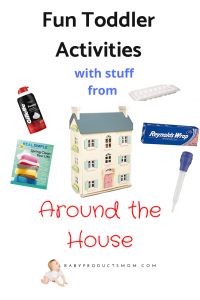
There’s nothing like a good book to get away from it all. What are you reading for fun these days?
BabyProductsMom just finished: All Over the Place: Adventures in Travel, True Love, and Petty Theft by Geraldine DeRuiter. In this excellent travel memoir, DeRuiter (quoting her husband) says:
“You can’t engineer quality time. You can only spend a lot of time with someone and hope that it turns into that.”
Hm….That got me thinking about possible pandemic perks, like extra quantity time at home with the kiddos that could turn into quality moments.
And that’s where this game plan post comes in!
Playing with your little one can help develop the cognitive, physical, language and motor skills he’ll need to be prepared for kindergarten, says Elissa Sungar, a former preschool teacher and the co-creator of ifnotyouwho.org. The free website guides parents through 300 short and fun daily activities to help them make sure their child is ready for kindergarten.
It’s always the right time to have fun with your little one. And it’s never too early to help your toddler get ready for Kindergarten.
Kindergarten readiness is vital for a child’s long-term academic success. It’s estimated that of the millions of children who enter kindergarten each year, half are behind their peers socially and academically, which increases the risk of failure in school.
Of the half who aren’t prepared, up to 40 percent won’t finish high school. “So much brain development occurs before age 6. You want your child ready for kindergarten and you want your child’s classmates to be ready so they can challenge your child,” Sungar says. “We need everybody on board.”
Parents play a major role in the process and the subtle shifts in how you interact with your child can make a big difference.
To get the ball rolling, here are ideas for things to do with toddlers and preschoolers with stuff your probably have around the house.
These toddlers activities can help develop your child’s cognitive and fine motor skills. But your child will just know he’s having fun.
Fill up the tub
Toddlers love to splash around in water as well as pour it, strain and transfer it from one object to another. So plop your child in the tub along with items from your kitchen, such as plastic cups, a turkey baster or a strainer or just give them a sponge.
Toddler activities like this one–squeezing a sponge or turkey baster and transferring water from one cup–to another enhances fine motor development. Stay in the bathroom with your child, but feel free to sit back and watch the supervised fun unfurl.
Fill ice cube trays with water and add one drop of food coloring to each cube. Let the cubes freeze overnight. Then pop one or two ice cubes into your child’s bath water and watch her have a blast mixing the colors.
Add a drop of food coloring to little plastic bowls filled with shaving cream and give your child a paint brush or let her explore it with her hands on the side of the tub.
Make tinfoil letters
Ask your child to squeeze a sheet of tinfoil into a skinny tube then see what she can do with it. Can she make a circle? A triangle? A letter, like a b? Be sure to show her what a “b” looks like if she doesn’t know or point to letter examples on food labels.
Have your child go on a letter hunt
The best toddler activities are simple. Like this one: Grab a magazine or a flyer from the mail and have your child circle letters, numbers, animals or people with a marker.
Playing Pointers for Toddler Activities
There’s more to playtime with a toddler than you might think. Sungar offers these tips for making the most of it.
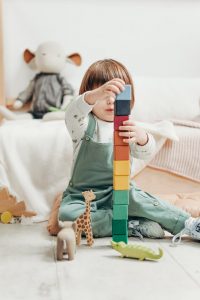
photo by cottonbro from Pexels
Let your child take the lead
During toddler activities, it’s tempting to take over, as in: “Now it’s time to dress the baby doll. Now it’s time to give the baby a bath.” “Many adults think play should be a certain way,” Sungar says. But that’s limiting. To enhance a child’s creativity and confidence, guide her instead.
“While you’re playing with your child, narrate what your child is doing. Ask questions about why she’s doing what she’s doing and what comes next, as in: “Now, you’re giving baby a bath. What’s baby going to do after her bath?” Sungar says. Letting your child run the show gives her a sense of control, which helps develop her thinking skills and solve problems on her own.
If she has a tough time getting the baby undressed, for example, don’t do it for her. “It’s critical to let kids explore, learn from their experiences and fix problems as they happen,” Sungar says.
Give explicit feedback
Throughout your child’s play time, give specific praise and avoid negative feedback. Instead of saying, “good job,” for example, when your child shows you a picture he painted, you might say, “I like how you used the blue and the red paint. Those colors mix well together.”
Giving your child pointed advice is more valuable than vague remarks because it gives your child direction and helps build his vocabulary. The more words, the better. “The actual number of words kids hear each day is crucial to their long-term development,” Sungar says.
Allow free play
Give your child the space to do her own thing. “Preschoolers need at least four hours per week—up to a roughly half an hour each day–of unstructured play time other than preschool,” says Sungar. Down time allows children to think creatively and gives them a mental breather.
If your child doesn’t know what to do, provide options, such as “Would you like to draw or play with blocks?” Then, go do what you need to do and check back in with your child occasionally.
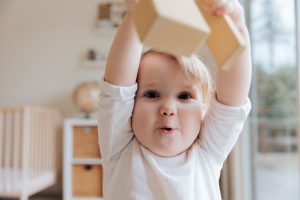
Photo: Tatiana Syikova for Pexels
Take a screen break
Even if your child’s favorite app is “educational,” your child isn’t learning through a physical experience when she’s using a screen.
“Preschoolers learn a lot with their bodies and need to try something, fail at it and then try something new,” Sungar says. “When they’re just using their thumbs or index finger on a touch screen, they’re not using the muscles in their hands, for example, which are crucial for holding a pencil, using scissors and throwing a ball.”
Pin it!

More Fun Stuff to Do with Bonus Home Time:
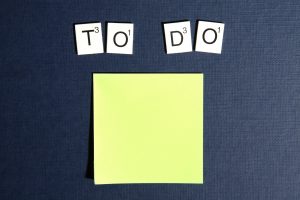
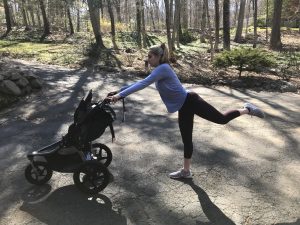 Get in shape with your jogging stroller
Get in shape with your jogging stroller
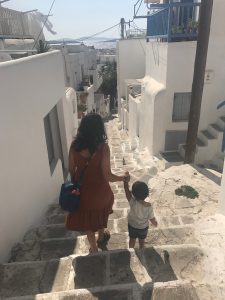 Travel with your toddler vicariously (by reading about how this couple traveled around the world with their 2 year old)
Travel with your toddler vicariously (by reading about how this couple traveled around the world with their 2 year old)
 Plan your child’s post-pandemic birthday party
Plan your child’s post-pandemic birthday party









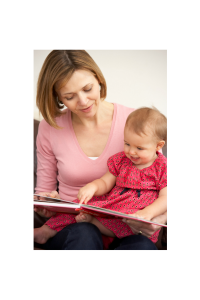 Freshen up your toddler’s reading list
Freshen up your toddler’s reading list
Leave a Reply